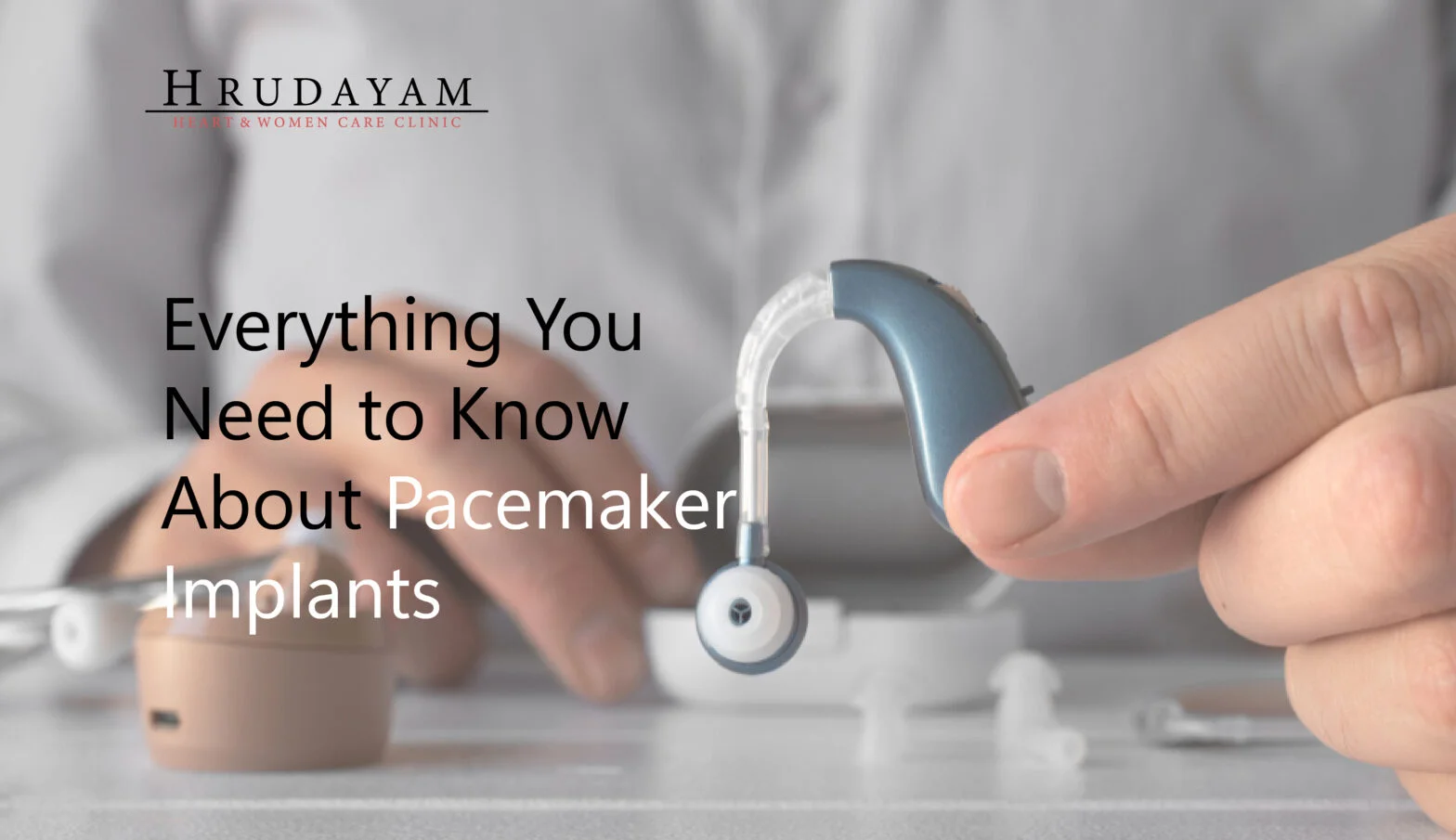Hrudayam Heart & Woman Care Clinic
Everything You Need to Know About Pacemaker Implants
- Pulse generator: A small box that contains the battery and circuitry.
- Leads (wires): Thin, insulated wires that connect the pulse generator to the heart.
Pacemakers are typically used to treat arrhythmias—abnormal heart rhythms that are either too fast, too slow, or irregular. They send electrical signals to the heart to correct these issues and ensure it beats at a normal rate.

Why Do You Need a Pacemaker?
Pacemakers are recommended for individuals who experience heart rhythms that are too slow (bradycardia) or have irregular rhythms that can cause symptoms like dizziness, fatigue, or fainting. Conditions that may require a pacemaker include:
- Sinus node dysfunction: A condition where the heart’s natural pacemaker fails to regulate the heart rate properly.
- Atrioventricular (AV) block: When the electrical signals between the atria and ventricles are delayed or blocked.
- Heart failure: In some cases, pacemakers are used to help manage heart failure and improve cardiac function.
- Sick sinus syndrome: A group of disorders that result in the heart’s natural pacemaker (the sinoatrial node) malfunctioning.
If you have one of these conditions, your doctor may recommend a pacemaker to help regulate your heart rhythm and improve your quality of life.
How Does a Pacemaker Work?
A pacemaker uses electrical impulses to stimulate the heart, ensuring it maintains a consistent, steady rhythm. When the pacemaker detects that your heart is beating too slowly, it sends small electrical signals through the leads to prompt the heart to beat at the correct rate.
Some modern pacemakers have rate-responsive capabilities, meaning they can adjust the heart rate depending on the body’s activity level. For example, if you’re exercising and your body needs more oxygen, the pacemaker will speed up your heart rate to match your physical needs.
The Pacemaker Implant Procedure
The process of getting a pacemaker implant typically involves the following steps:
- Preoperative Evaluation: Your doctor will assess your overall health, review your heart history, and conduct some diagnostic tests like an electrocardiogram (ECG) or echocardiogram to confirm the need for a pacemaker.
- Anesthesia: The procedure is usually done under local anesthesia, meaning the area around your chest will be numbed, and you’ll be awake during the procedure. In some cases, sedation may be used to help you relax.
- Implantation: The doctor makes a small incision below your collarbone and inserts the leads into a vein. The leads are guided to the heart, and the pulse generator is implanted just under the skin. The pacemaker is then tested to ensure it’s functioning properly.
- Postoperative Care: After the procedure, you’ll be monitored in a recovery area for a few hours or overnight. The doctor will ensure the pacemaker is working correctly and that you’re stable before you’re discharged.
Types of Pacemakers
There are different types of pacemakers, each designed to treat specific heart rhythm issues:
- Single-chamber pacemaker: This device has one lead that is typically placed in the right ventricle to help regulate the heart’s rhythm.
- Dual-chamber pacemaker: It has two leads—one placed in the right atrium and one in the right ventricle. It helps coordinate the timing between the atria and ventricles for a more natural heart rhythm.
- Biventricular pacemaker: This type of pacemaker is used for patients with heart failure. It helps both ventricles beat in sync, improving the heart’s efficiency.
- Leadless pacemaker: A newer, smaller type of pacemaker that is implanted directly into the heart without the need for leads. It’s less invasive and may be suitable for some patients with specific conditions.
Conclusion
A pacemaker implant can provide essential life-saving benefits for individuals with heart rhythm disorders. Understanding the procedure, types, risks, and benefits of pacemaker implants can help you make informed decisions about your heart health. With proper care and regular monitoring, a pacemaker can significantly improve your quality of life and heart function.
If you’re considering a pacemaker, consult with your healthcare provider to discuss your options and determine the best treatment plan for your specific needs.
FAQs of Dyslipidemia
What is a pacemaker, and why do I need one?
A pacemaker is a small medical device implanted under the skin to help regulate heart rhythms. It’s used for individuals with arrhythmias, especially those with a slow or irregular heartbeat, ensuring the heart maintains a proper rhythm and function.
How does a pacemaker work?
A pacemaker uses electrical impulses to regulate the heart’s rhythm. It sends signals to the heart when it detects an abnormal heart rate, helping to restore a normal beat. Some pacemakers can adjust the heart rate based on activity levels.
What are the types of pacemakers available?
The three main types of pacemakers are:
- Single-chamber pacemaker: One lead is used, typically in the right ventricle.
- Dual-chamber pacemaker: Two leads are used, one in the atrium and one in the ventricle, helping synchronize the heart’s rhythm.
- Biventricular pacemaker: Used for heart failure, it helps both ventricles beat in sync.
- Leadless pacemaker: A smaller, lead-free device implanted directly into the heart for certain patients.
